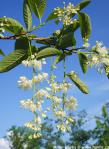Pterostyrax corymbosa

Pterostyrax corymbosa
little epaulette tree
little epaulette tree
| SIZE/TYPE | taller shrub |
|---|---|
| USUAL HEIGHT | 3-5m |
| USUAL WIDTH | 2-4m |
| LEAVES | deciduous broadleaf |
| COLOUR OF LEAVES |
 green green |
| FLOWERS | showy |
| COLOUR OF FLOWERS |
 cream cream
|
| BLOOMING TIME | June - June |
| LOCATION | full sun |
| SOIL TYPE | acidic (peaty) |
| SOIL MOISTURE REQUIREMENTS | evenly moist (dislikes drought) |
| USDA zone (lowest) | 5b (down to -27°C) |
| WINTER PROTECTION | |
| FOR ZONE 5+6 |

|
| FOR ZONE 7 |

|
| BELONGS TO CATEGORIES |
Deciduous broadleaf Rarities |
Epaulette tree comes from China and Japan. There are two very similar species and even though they are both called the same common name, this one often gets the epithet v. It is a mid-sized, often multi-stemmed tree or spreading shrub, about one third smaller than p.hispida.
Its main attraction are the pendent panicles of creamy white flowers in early summer. They do look like racemes but they are compound of secondary branches that bear individual flowers hence its botanical correct classification pendent panicle. The flowers are small, bell-shaped, with conspicuous stamens. The panicle itself is a good give away that helps you determine which pterostyrax you are looking at: p.hispida produces quite regular, slim panicles where the number of flowers gradually decreases downwards, and the tip of the panicle is decorated with usually only one or two flowers. While p.corymbosa makes panicles where its secondary branches are of almost even number of flowers and the bottom one does not aim downwards but lays horizontally as if reluctant to be the last one.
The leaves are deciduous, broadly elliptic or obovate, partly glossy, with conspicuous veins, rich green in summer, turning yellow in autumn. In very acid soil the autumn colouring can be enriched with orange and some scarlet red but is not guaranteed.
Grow epaulette tree in moist, neutral to acid soil rich in humus. It is fully hardy in our climate and often much smaller than in Japan where it can reach well over 10m. Being difficult to propagate it belongs to rarities. Hardy to min. -25°C (USDA zone 6) but plants older than 3 years with ripened wood can take down to -27°C for limited time.
Last update: 09-01-2014
SIZES and PRICES
CURRENTLY SOLD OUT
GLOSSARY
|







